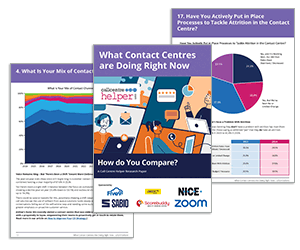This blog summarizes the key points from a recent article by David McGeough at Scorebuddy, where he explores how to improve customer satisfaction in a call centre with actionable steps you can take.
Your contact centre’s customer satisfaction (CSAT) rating plays a major role in determining your overall service performance. For many customers, their experience with your call centre is the primary (or only) interaction they’ll have with your brand – which means it needs to leave a strong impression.
If your CSAT score is low, it’s a clear sign that something isn’t working. Poor service experiences can quickly lead to:
- Higher customer turnover
- Decreased revenue
- Damage to your brand reputation
To effectively raise your CSAT, you’ll need to assess every aspect of how your call center operates—especially how agents manage customer interactions. It’s not just about quick resolutions, but creating a positive experience every time a customer reaches out.
Understanding CSAT: What It Means for Contact Centres
Customer satisfaction is a fundamental metric that gauges how content customers are after interacting with your service or team.
Typically captured through a brief survey-often a 1 to 5 rating scale-it reflects their perception of the service received.
To calculate CSAT, divide the number of satisfied responses (4s and 5s) by total responses, then multiply by 100. For example, if 80 out of 100 respondents gave a positive score, your CSAT would be 80%.
Happy customers tend to spend more, return often, and require less support. In fact, 60% of buyers are 3.5x more likely to return to businesses that deliver strong experiences. CSAT complements other performance metrics like:
- Net Promoter Score (NPS)
- Average Handle Time (AHT)
- QA evaluations
Improving customer satisfaction goes beyond politeness-it’s about anticipating and exceeding expectations at every level.
13 Ways to Improve Customer Satisfaction In Contact Centres
1. Make Every Customer Feel Known
Studies show that 79% of consumers expect personalization, according to Shep Hyken.
When agents tailor conversations using CRM data-like preferences or past issues-it builds rapport and boosts satisfaction. Small gestures, like using someone’s name, can make a big difference.
2. Offer Support 24/7 on all Channels
Customers want flexibility in how they connect. Whether it’s by chat, phone, email, or social media, ensure the journey is smooth and consistent.
A unified system helps your team manage multi-channel support more efficiently-and avoids repetitive questions across touchpoints.
3. Have Self-Service Options Available
Today’s consumers often prefer self-service, this is especially known in millennials and GenZ, with 38% saying they would completely give up on an issue if they couldn’t use self service.
Tools like chatbots, FAQs, or IVR systems allow them to resolve basic issues fast. Just make sure there’s always a way to reach a live agent if needed.
4. Take Initiative Before Problems Arise
Using data to identify trends or pain points lets your team act before a complaint is made. Proactive outreach shows customers you’re attentive and committed. Follow up on past issues or notify users of outages before they happen.
5. Train Agents to Show Genuine Empathy
Most customers will agree that empathy comes before customer experience.
Emotional intelligence is a must. Even if the issue isn’t resolved right away, empathy can completely shift the mood of an interaction. Train staff on active listening and de-escalation to create human-centred conversations.
6. Boost Agent Performance with GenAI
You can now use GenAI in several ways in your contact centre to help improve customer satisfaction. Some of these ways include:
- Suggesting responses/ summaries of past interactions with real-time assist
- Sentiment analysis
- Handling after call work and any administrative tasks
- Providing self-service tools to help handle the more common queries
Although GenAI has become very useful to call centres, it is important to use it to empower your agents instead of replace. Make sure there’s always a human touch when needed.
7. Celebrate Loyalty and Long-Term Customers
To help strengthen customer relationships, it is good to acknowledge repeat buyers or long term clients. Some ways you can do this is by:
- Offering personalised offers
- Sending milestone messages
- Having a customer loyalty program
Every small token of appreciation helps build stronger, lasting relationships and brand loyalty.
8. Deliver Customised Coaching
Every agent has unique strengths and gaps, therefore you should personalise your coaching to your agents.
Using call recordings and QA insights, you can design individual coaching plans that will provide targeted learning and improvements. Tools powered by AI can help scale this, allowing for faster upskilling and measurable improvements.
9. Track the Right Metrics with QA
It is important track the correct metrics, CSAT alone doesn’t paint the full picture. Combine it with data from NPS, First Contact Resolution (FCR) and Average Handling Time (AHT), and more for a deeper view.
AI-enabled QA tools help uncover patterns and monitor tone, sentiment, and language use in real time.
10. Actively Collect and Respond to Feedback
One of the most important and effective ways to improve customer satisfaction is to listen to your customers. This can be done in may ways, including:
- Post call surveys
- Feedback forms
- SMS
Then close the loop by sharing what changes you have made based on their input. Customers feel valued when their voices lead to real improvements.
11. Map Out the Full Customer Journey
Instead of guessing the customers experience, actually see it from their point of view and understand each step a customer takes – from first contact to final resolution.
Pinpoint where any friction occurs, such as long waiting times or repeated transfers, and use QA data to streamline those interactions.
12. Build Peer-Led Support Communities
Online communities or forums can reduce strain on agents and empower customers to support each other.
When these spaces are moderated effectively, they become powerful tools for sharing knowledge, providing faster answers, creating trust and building loyalty.
13. Foster a Culture That Prioritizes CX
Excellent customer experiences start from the inside. When teams-from leadership to frontline-are aligned around CX, the results show. Celebrate success stories, share customer wins, and make service a core part of your company DNA.
Choosing the Right Tools to Measure and Improve CSAT
You need the right technology stack to track and improve customer satisfaction effectively. Some essentials include:
- Survey platforms: IVR, SMS, or email-based tools to gather instant feedback.
- Dashboards and analytics: Real-time visibility into agent and team performance.
- Quality assurance software: Score interactions and surface training opportunities.
- Sentiment analysis: AI-powered insights into emotional tone for deeper understanding.
Together, these tools help you connect feedback with outcomes and turn data into action.
Every Call Is a Chance to Improve CSAT
Customer experience is the heartbeat of your call centre. Poor service drives customers away – 76% say one bad experience is enough to switch providers. By making CSAT a priority, you build long-term trust and loyalty.
High satisfaction doesn’t just feel good-it pays off in retention, spend, and word-of-mouth. Start by auditing every interaction and finding those small, powerful ways to create delight.
This blog post has been re-published by kind permission of Scorebuddy – View the Original Article
For more information about Scorebuddy - visit the Scorebuddy Website
Call Centre Helper is not responsible for the content of these guest blog posts. The opinions expressed in this article are those of the author, and do not necessarily reflect those of Call Centre Helper.
Author: Scorebuddy
Reviewed by: Megan Jones
Published On: 16th Apr 2025 - Last modified: 23rd Apr 2025
Read more about - Guest Blogs, David McGeough, Scorebuddy






 Scorebuddy is quality assurance solution for scoring customer service calls, emails and web chat. It is a dedicated, stand-alone staff scoring system based in the cloud, requiring no integration.
Scorebuddy is quality assurance solution for scoring customer service calls, emails and web chat. It is a dedicated, stand-alone staff scoring system based in the cloud, requiring no integration. 





























